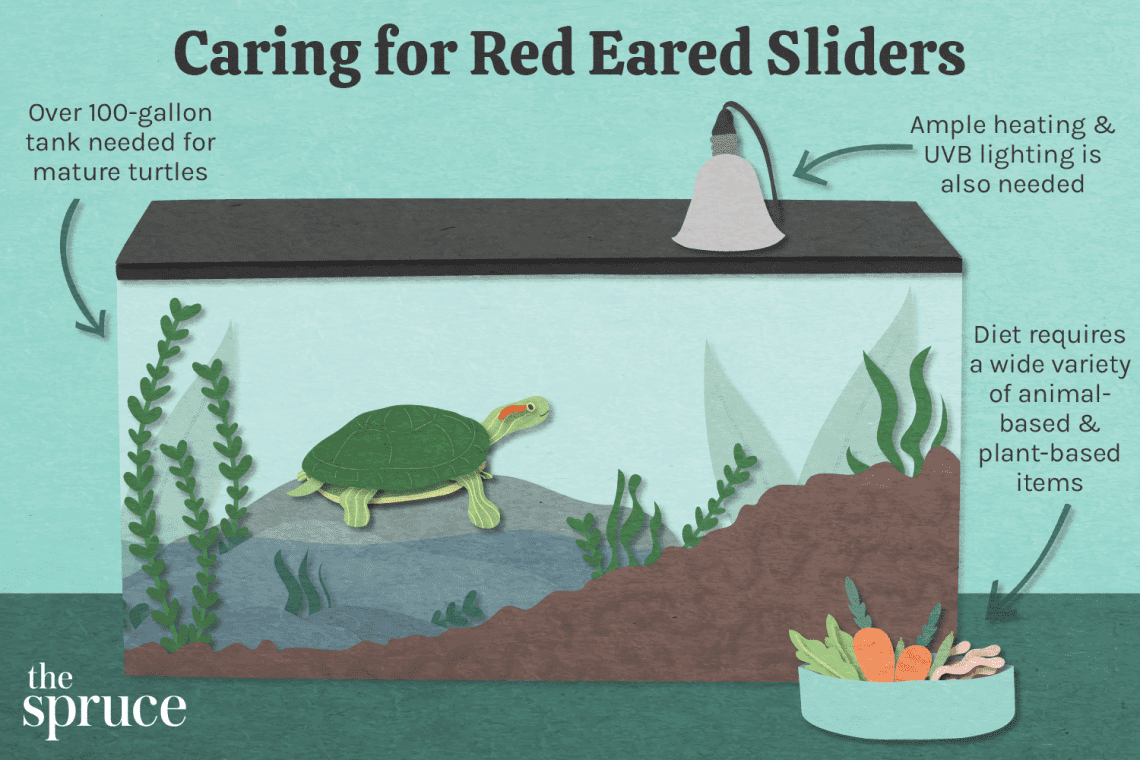
How long do red-eared turtles live, keeping and caring for them
Many animal lovers wonder: what is the lifespan of a turtle. It is difficult to give a definite answer to this question. Everything will depend on the species to which the pet belongs. Conditions of detention also play an important role. In this article, we will discuss how long a turtle lives, how to care for it at home, so that it pleases you for as long as possible.
Contents
How long does a turtle live?
For example, the lifespan of a giant tortoise is over 50 years. This is much longer than the life of any vertebrate animal. European bog turtle lives an average of 20-25 years.
The main difference between these cute creatures and other animals is their slow metabolism. Therefore, they can go without food and even without water for a long time. In addition, they have very high immunity, in connection with this, their injuries heal quickly and they are resistant to various infections. It also helps them to be remarkably hardy. Few people know that turtles have the unique ability to stop their heartbeat and then start their “motor” again.
All currently existing species of turtles descended from cotylosaurus – their terrestrial ancestor. The descendants of this animal in the course of evolution have learned to live in both salt and fresh water. It is worth noting that the question of the life expectancy of a turtle is quite lengthy. Well, judge: a tortoise lives on the Galapagos Island, which, according to local residents, has reached 300 years old. Although, this may well be just a legend, because scientists say that large turtles (which include the long-liver) are able to live up to 180 years, but no more.
In any case, the answer to the question of how long the red-eared turtle lives depends directly on people who constantly destroy the habitat of individuals with their actions. Mankind has repeatedly made attempts to relocate turtles from their usual habitats, in addition, people barbarously exterminate these animals for their meat, skin and shell.
How long does a turtle live at home?
There is no single answer to this question either. This largely depends on the conditions of their detention. If the conditions you have created are suitable for a given species of red-eared turtle, for example, a red-eared slider turtle can safely live with you up to 30 years. Along with this, there have been cases when, at home, a turtle lived for four decades to the delight of the owner.
Description of red-eared turtles
The genus of these turtles (Chrysemys) has 8 species. The habitat of their representatives is the reservoirs of South and North America. The shell of these animals reaches 28 cm in length. The color of the shell and the pattern differ in different individuals. For example, sexually mature males are completely black. Their main distinguishing characteristic is the presence of 2 orange, yellow or red spots that can be seen on the sides of the head, hence their name.
Subspecies of red-eared turtles
Scientists subdivide the species of red-eared turtles into several subspecies. For example, the Colombian subspecies, which has been listed in the Red Book as the most vulnerable for many years. The Colombian tortoise is the smallest of its relatives. It lives in the waters of Lake Maracaibo, located in northwestern Venezuela. It can settle in lagoons and swamps, in the lower reaches of the basins of the Sinu and Magdalena rivers. This subspecies is protected in Colombia at the legislative level, thanks to which the export of turtles outside the state was minimized.
German lovers of these individuals released them into natural reservoirs in Germany and some other states in Europe. Due to the fact that these countries have a predominantly mild climate, the turtles have taken root well there. Today, European animal advocates, together with biologists, are calling for not having red-eared turtles at home.
How to determine the sex of a red-eared turtle?
If several turtles live in an aquarium, then their gender is very easy to determine. Males differ from females in that they have has a long tail, wider at the base. In females, the tails are thin and short. Males also have longer front claws than females.
Habitat and its impact on life expectancy
Anyone who wants to extend the life of their pet should definitely be interested in its natural habitat. After all, if you try to repeat the natural conditions of these animals at home, then their life expectancy will increase. Red-eared turtles live in swampy shallow waters in the eastern United States and northeastern Mexico.
At home, they received the nickname “red-eared gliders” for the manner of running away when they are in danger, while sliding their abdomen on the ground, this helps them to reach the water sooner. They have every reason to be afraid of people. The locals often eat meat adult turtles and their eggs.
Lifespan of red-eared turtles
The future owner of these funny creatures, dressed in a shell, should be aware that he gets himself a little pet for almost a lifetime. There are cases when in captivity turtles live to a very old age (30-40 years or more). But this happens to those owners who understand that this animal is not a toy, and it needs daily attention. If you do not follow the vital rules, then your red-eared pet can quickly expire, and even good genes inherited from wild ancestors cannot help him.
Often people are interested not only in how long aquarium turtles live, but also how to determine their age. After all, it is not always possible to have a tiny turtle and raise it from a very young age. Turtles are often given or purchased as adults. Approximate calculations can be done in a simple way – measure the diameter of the shell. Proceed from the following data: for the first year of life, a turtle grows to an average of 6 cm, then for each subsequent year add 2-3 cm. At 6 years old, the male’s shell will reach about 17 cm, and the female – up to 20 cm. However, it is worth remembering that gradually their growth slows down, and the addition is already no more than 1-2 centimeters.
Reproduction
The breeding season for red-eared turtles living in the Southern Hemisphere is from September to December, and living in the Northern Hemisphere from April to June. As a rule, mating takes place underwater. They arrange their cozy nests on the sand near the water, in places shaded by plants, so as not to overheat.
Male pet turtles reach sexual maturity by 4 years, females – by 6 years. The mating season at home is from February to May. After mating, the female comes out onto land to lay her eggs. Therefore, it is very important for these animals to create appropriate conditions in captivity. Small turtles are born in 105-150 days, the ambient temperature should not fall below 21 degrees. The length of the cubs is 3 cm.
Offspring are born during the rainy season, which lasts from September to December in places located north of the equator, and in June – in the south of the equator.
Food
This is one of the most important factors that everyone who decides to settle a red-eared turtle in their home needs to know. With proper nutrition, these animals will live in captivity for at least thirty years. Follow the right diets – this will increase the life expectancy of an individual.
It is important to remember that turtles – diurnal animalsso you need to feed them during the day. The basis of their diet is dry aquarium food. At the same time, red-eared turtles will not refuse such delicacies:
- bloodworm;
- earthworms;
- pipe maker;
- aquatic crustaceans – hamarus; the most useful for turtles is live hamarus, which is on sale in winter;
- insects and snails – they are needed in order to bring the turtle’s diet as close as possible to the natural one.
Meat supplements will allow you to balance the lack of protein in the turtle’s diet. It is enough just to give the animal boiled or fresh thinly sliced meat.
Vitamins play a special role in turtle nutrition. They not only improve the well-being of the pet, but also increase its life expectancy. Red-eared turtles need to be given vitamin supplements:
- An oil solution of vitamin D, it is enough to give it once a week, putting a few drops on food.
- Vitamin A is given less frequently – once every two weeks.
Maintenance and care
We have already mentioned that the lifespan of your turtle will directly depend on how well the habitat is organized. Make every effort to ensure that the conditions of detention are close to natural.
Remember that turtles need not only water, but also land. The volume of the aquarium should be 150 liters per individual. At the same time, it is important to comply the proportions of water and land – approximately 3: 1.
In pet stores, you can purchase a special island where your turtle can walk or just relax. You don’t need to make it yourself from improvised plastic tools – it will be difficult for the turtle to climb onto it on a slippery surface, which will lead to the animal’s refusal to walk. And this, in turn, will definitely affect the well-being and life expectancy.
Make sure that the temperature in the terrarium is always maintained at a fairly high temperature. This can be easily achieved thanks to a special lamp. Don’t change the water more than once a week. Take care of your pet, and he will delight you for many, many years!





